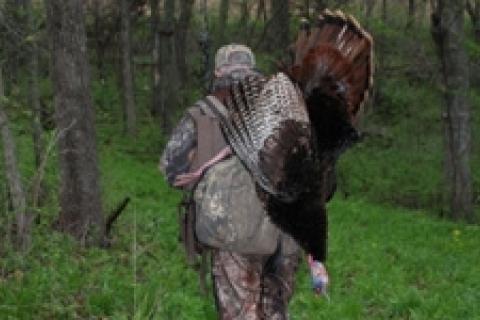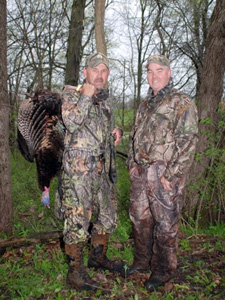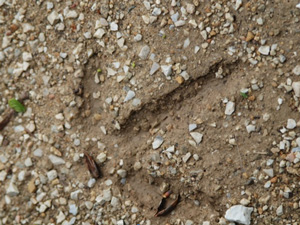
 Today's turkey hunters learn quickly. With the mass of media information available through magazines, outdoor TV shows, DVDs and seminars, gobbler chasers are on top of the latest in tactics and equipment in an instant. I have even seen hunters pull out an iPhone to check what they should do in a given situation to dupe a gobbler.
Today's turkey hunters learn quickly. With the mass of media information available through magazines, outdoor TV shows, DVDs and seminars, gobbler chasers are on top of the latest in tactics and equipment in an instant. I have even seen hunters pull out an iPhone to check what they should do in a given situation to dupe a gobbler.
Despite all the technological advances in hunting equipment and devices, the wild turkey still wins the wits battle more often than not. “It is the challenge of the entire hunt experience which keeps hunters coming back,” said turkey hunting guru Ray Eye. “A turkey hunt, from beginning to end, is fraught with obstacles, challenges and possibilities for failure. Learning from the mistakes is key to becoming a better turkey hunter.”
From the early days of turkey hunting, when Big Robert, a character in Robert Hitt Neill’s classic, “The Flaming Turkey,” caught his shirt on fire from the ashes of a Prince Albert cigarette, just as he was about to pull the trigger on a big boss swamp gobbler, to the ultra-stoked, ultra-educated, ultra-equipped hunter of today, the journey of a turkey hunter is filled with mishap and pandemonium.
![]() TIP: Shop Bass Pro Shops hunting gear - The Turkey Shop - LINK
TIP: Shop Bass Pro Shops hunting gear - The Turkey Shop - LINK
“Every turkey hunter makes mistakes,” said Alex Rutledge. “And most of us make mistakes on every turkey hunt, but it sure feels good when everything goes the way we want and we get to wrap a tag around a gobbler’s leg.”
Volumes have been written about turkey hunting and all that goes with it. Everything from preparing yourself mentally and physically before the hunt to visualizing the gobbler you will harvest by utilizing the latest and greatest equipment to get the job done have been available for decades. However, failure in the turkey woods is still a constant. A gobbler hunter’s goal must be to improve his skills constantly.
Expert turkey hunters all agree that outsmarting a world-wise gobbler is about as tough a challenge as exists in the wild. “But, I still love it,” said Mike Conaway. “I’m always trying something new to give me an advantage. Still, it flabbergasts me that a bird with a brain the size of a pea can outsmart me the vast majority of the time.”
Despite the challenges of hunting the wild turkey, several key factors seem to be agreed upon by consistently successful turkey hunters. Scouting well before the hunt is most often mentioned in group conversations among the experts. Knowing where the birds live and roam at any time of the day is key. Far to many hunters relay on birds to give themselves away by gobbling. All too often turkeys don’t gobble much and can travel hundreds of yards between gobbles. Knowing how turkeys travel on their daily routine gives the hunter a tremendous advantage.
 |
| Scouting is one of the most important elements of a successful turkey hunt. |
From that point, discussions of turkey behavior by expert hunters goes to the four corners of the compass. Each harbors his favorite methods of hunting. Some swear by the run and gun method of calling loud and long and moving on if a bird doesn’t answer quickly. Others prefer the patience game, contending that if you know there are birds in the area, you should wait them out.
The best turkey hunter I have ever known, the late Rev. Roscoe Snowden, lived by the turkey hunting rule: “If I call and wait, they will come.” Religiously, he would set up to call the first gobbler he heard in the morning. When shooting hours ended at 1 p.m., Rev Snowden would still be sitting in the same spot, unless he had dispatched the gobbler around 11 a.m., which occurred more often than not. “Patience is a virtue,” he often said.
“Stealth is the game,” says Ray Eye. “I like to get in tight on the birds on the roost, to about 60 yards. That puts me right in their bedroom. I want to be the first thing that gobbler hears when it wakes up in the morning.”
Eye’s tactics often reward him with a quick kill, soon after a gobbler hits the ground. “I like to find a gobbler roosted by itself, or with some distance between it and hens. That makes it a lot easier to convince the tom that I am a desirable, hot hen.”
Should Eye find a gobbler that has hens on the roost nearby, he goes to work on the dominant hen. If she accepts his challenge for a duel, the gobbler will come tagging along behind her.
“The key to this whole scenario,” says Eye, “ is to roost the gobbler the night before. I use high points as listening points. Once I hear a bird fly up, I move in to investigate. If the tom is alone, I get close enough to know exactly which tree it is roosting in.”
 Stealth takes practice and most hunters will spook some birds in the learning process.
Stealth takes practice and most hunters will spook some birds in the learning process.
“Knowing every inch of the ground you hunt is key to consistent success,” said Conaway. “ Every dip, hollow, ditch, creek, thick patch of brush and fence line can serve as barriers where a gobbler will hang up. A hunter needs to know where these barriers exist and try to avoid doing battle with birds near these areas. However, in some circumstances these same barriers may become your ally, if you need to change locations and approach a bird from another direction.”
“Experienced hunters have made every mistake in the book, more than once,” continued Eye. “It is the guys that don’t give up that enjoy the success. Of course, blind luck plays a role in the demise of some gobblers. Some days gobblers run in to anything that sounds like a rusty gate hinge. Other days, the real Mccoy couldn’t budge a gobbler.”
Eye is the most consistent gobbler slayer I have ever known. Much of his success comes from an unusual understanding of the turkey vocabulary. I have watched him stir gobblers to a fighting frenzy every month of the year. He strongly believes that hunters have the best chance of improving their turkey hunting skills by spending time with turkeys as much as possible, listening and observing.
Following Eye’s lead, I scouted a gobbler for months a few years back. I knew its daily routine better than my own. The cagey old gobbler was so grouchy that few other birds would have anything to do with it. It roosted alone, in the same tree, for weeks at a time. Dozens of times I watched it fly down to a small, flat, bench just above its roost tree.
On opening morning I eased into position well before daylight. My goal had been to reach another pocket flat jut 30 yards from where the bird always flew down. That would put me within 60 yards of the roost tree.
All went well until the last 5 yards to my pre-selected location. My feet became tangled in a discarded piece of barbed wire. Head over heels I tumbled down the hillside in the dark. I recovered just in time to hear the heavy wingbeats of that old gobbler sending him off into parts unknown.
I could hear Eye’s voice ringing in my ears, “know thy territory.”
- 3024 views

